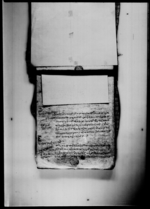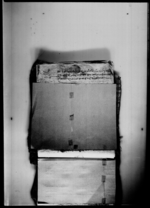A copy of a lālamohara from King Rājendra appointing Rāmacandra Khatrī to perform Dasaĩ rituals (VS 1874)
ID: K_0013_0024E
Edited and
translated by Astrid Zotter
in collaboration with
Pabitra Bajracharya
Created: 2019-06-09;
Last modified: 2023-03-20
For the metadata of the document, click here
The accompanying edition, translation/synopsis and/or commentary are available under the terms of the Creative Commons Attribution-ShareAlike 4.0 International License
Abstract
The lālamohara from King Rājendra of which this is a copy appoints Rāmacandra Khatrī to follow his predecessor Keharī Siṃ Thāpā in carrying out duties during the Dasaĩ and Caityā Dasaĩ festivals at Gorkha, and allocates land to him as remuneration.Diplomatic edition
[57]
1पो१३पा६१सी२३१८३नं12भंनौहर्ष
3हेनौराम1आगेरामचन्द्रषत्रीकेकेहरीसींथापाकोषाये़लगोर्षामा
2ठुलोदसैचैत्यादसैकोकाजपरापुर्वकारीतसंगराम्रोगरीतै
3लेगर्नुतस्कोषानगीसेराकपर्दारमार्फतकोवासपुरषुवा∙
4१ताहीकाषेतमध्येषेत३।[?]सींवानीयालेषाय़ाकोगाषु[Unknown seal]
[58]
1५८नं[Unknown seal]5षुवा१जागीरगरीवक्स्यौंषातीरज्मासंग∙गोर्षामावसीदुवैदसै
6कोकाजवीधीपुर्वकगराईषेतषुव़ाजागीरजानीभोग्यगर
7ईतीसम्वत१८७४सालआषादवदी६रोज५सु¯¯¯¯¯¯
Translation
[57]
[In the left margin:]
Bundle 13 pā 61 sī 231, no. 831
The one who said was Nau[sindā]Harṣa3
The one who watched was Nau[sindā] Rāma
[Main text:]
Āge: To Rāmacandra Khatrī
[We grant to you] Keharī Sīṃ Thāpā's holdings (khāyela): perform the tasks relating to the Great (ṭhūlo) Dasaĩ and the Caityā Dasaĩ at Gorkhā according to the customs [prevailing] from ancient times in a proper manner. As an emolument (khānagī) for that we grant [the following] crown land (serā), making [it your] jāgira: 1 plot of non-irrigated land (khuvā) [at] Vāsapura [that is allocated to jāgira holders] through the kaparadāra; among the irrigated land (kheta) at the same place, [a field measuring] 3 khetas; [and] 1 khuvā [at] Gākhu that has [hitherto] been enjoyed by ... Sīṃ Bānīyā4 .
[Unknown seal]
[58]
[p.] no. 585
[Unknown seal]
Reside in Gorkhā conscious of your duties, have the tasks of both Dasaĩs performed according to the rules, consider the khetas and khuvās as [your] remuneration (jāgira) and enjoy [the attendant fruits].
Thursday, the 6th of the dark fortnight of Āṣāḍha, in the [Vikrama] era year 1874 (5 June 1817 CE).6 Auspiciousness.
Commentary
The document speaks about tasks (kāja) to be performed by the newly appointed person during both Dasaĩ festivals at Gorkha. These could be tasks related to the rituals at Gorkha Palace or at another venue in the larger territory of Gorkha. The text does not specify them, nor does it provide any additional information about the appointee, apart from his name, Rāmacandra Khatrī.
A person of this name is known to have pledged his allegiance to King Gīrvāṇayuddha during his enthronement (PN_0001_0017) in the month of Māgha in VS 1855 (1799 CE). In this pledge, memorialized in the form of a copperplate, Rāmacandra Khatrī is identified as a subedāra and as "the grandson of Raṃjai Khatri and son of Akabara Khatri" (raṃjai khatrikā nāti akavara khatriko chorā, PN_0001_0017, margin). The same person turns up again in a document appointing him as the military commander (subbā) of Jumla in the month of Āśvina in VS 1862 (1805 CE), with a command over two companies (Regmi 1987: 151). In his synopsis of the document, Regmi refers to him as "Ramachandra Khatri of Gorkha, son of Akbar Khatri and grandson of Ranjan Khatri" (ibid.). It seems possible then that the same Rāmacandra Khatrī who had long rendered honourable military service was appointed later to take over some ritual duties in the prestigious royal palace and to enjoy the privilege of permanently settling at Gorkha. It is also possible, however, that the military officer Rāmacandra Khatrī and the person appointed by the present document were two different persons.


